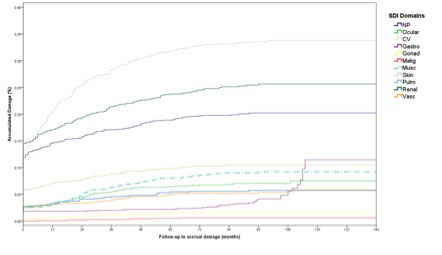Session Information
Session Type: Poster Session (Monday)
Session Time: 9:00AM-11:00AM
Background/Purpose: Patients with Systemic Lupus Erythematosus (SLE) are at risk of accumulating damage, having an impaired quality of life and experiencing a premature death. The different domains and items of the SLICC/ACR Damage Index (SDI) and the predictors of their development and progression in patients from a large multiethnic, multinational Latin American Lupus Cohort were studied.
Methods: 1,385 SLE patients, with a recent SLE diagnosis (< 24 months and >6 months to comply with SDI definition), were studied and followed-up for a mean of 47.0 (SD 25.1) months. Socio-demographic and clinical variables were assessed. The 41 items and 12 domains of SDI were evaluated annually. Kaplan-Meier (Log-rank test) and Cox frailty models as multivariate analysis were performed.
Results: At cohort entry 565 patients (40.8%) had damage score ≥1, with a mean baseline SDI 0.66 (SD 1.01). During follow-up 658 patients (47.5%) accrued new damage ≥1, with a meantime between cohort entry and new damage of 33.2 months (SD 26.2). 11.3% accrued severe new damage (SDI ≥3 points).At last follow-up: 952 patients (68.7%) had a total damage score ≥1, with a mean final SDI of 1.57 (SD 1.67). 76 patients (5.5%) died during follow-up, at a mean time of 50.0 (SD 23.5) months from cohort entry; 56.6% of they had damage at baseline, with a mean SDI of 1,12 (SD 1.4). The highest proportion of new damage occurrence was in the skin domain, followed by renal and neuropsychiatric domains, and the lowest proportion were for gonadal and malignancy domains, as shown in Figure 1 of damage accrual for the 12 SDI domains. Multivariate analysis (including gender, age, medical coverture, country of origin, race, rural or urban residency, socioeconomic status, education years, SLE duration, and diagnosis delay), to investigate predictors of different damage domains, showed that higher baseline SLEDAI scores associated with a significant Hazard Risk for new damage in the neuropsychiatric, ocular, cardiovascular, skin, pulmonary and renal domains. There were differences according to country of origin, with more new damage occurring in patients from Perú and Argentina, and with less damage accrual occurring in those from Guatemala, Cuba and Brazil. No other differences were observed. At last follow-up: alopecia was the most frequent SDI item (30.4% SLE) followed by proteinuria >3.5g/d (11.2%), estimated glomerular filtration range < 50% (9.0%), and seizures requiring therapy for >6 months (7.5%). The other 37 SDI items were present in < 5% of the members of the cohort.
Conclusion: In this cohort, skin (mostly alopecia) was the most prevalent domain in damage accrual. SLEDAI predicts damage accrual in several domains, including major organs, reinforcing the need for early treatment intervention to minimize the inflammatory process and consequent damage. Relevant differences according to country of origin were identified.
To cite this abstract in AMA style:
Mimica M, Padilla O, Aguilera F, Cavalcanti F, Borba E, Guibert-Toledano M, Chacon-Diaz R, Vasquez G, Pons-Estel G, Cardiel M, Neira O, Amigo M, Bonfa E, Alarcón G, Pons-Estel B, Massardo L. Factors Associated with Accrual of Damage over Time in Patients with SLE: Results from a Multinational Latin American Cohort [abstract]. Arthritis Rheumatol. 2019; 71 (suppl 10). https://acrabstracts.org/abstract/factors-associated-with-accrual-of-damage-over-time-in-patients-with-sle-results-from-a-multinational-latin-american-cohort/. Accessed .« Back to 2019 ACR/ARP Annual Meeting
ACR Meeting Abstracts - https://acrabstracts.org/abstract/factors-associated-with-accrual-of-damage-over-time-in-patients-with-sle-results-from-a-multinational-latin-american-cohort/

